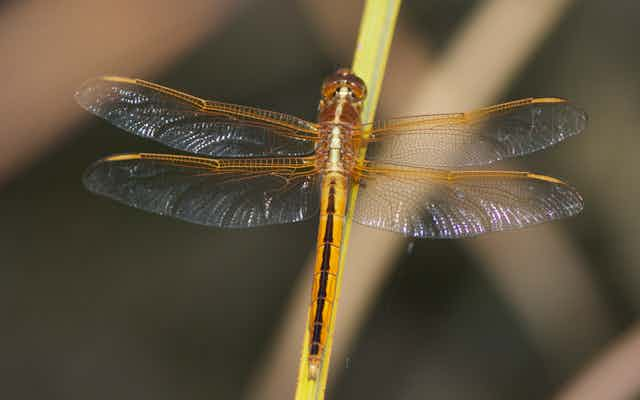Being able to focus on an important object or task while surrounded by distractions is a valuable skill.
It’s an ability that’s probably widespread in the animal kingdom, but is best known in large mammals such as predatory carnivores and primates.
When a lion is hunting a pack of zebras she needs to be able to focus on her target when the herd scatters in all directions at the start of the chase. A successful pursuit depends on being able to fixate on just one target and avoid distractions. (And zebras have evolved disruptive colouration to make this process harder than it might otherwise be.)
Some neuroscientists consider this “selective attention” to be too complex for the simple brains of insects such as the dragonfly.
But new research from our Centre for Neuroscience Research at the University of Adelaide suggests otherwise.
Catch!
Another familiar example of selective attention is a cricketer deftly catching a ball as it flies through the air at high speed. The cricketer detects the ball’s motion and trajectory and computes a precise intercept path for their outstretched hands.
This is usually done while running or diving, all the while keeping their gaze fixed on the ball while trying to ignore a complex backdrop of coloured hats and banners bobbing up and down.

That any animal can manage such feats demonstrates that the brain solves a set of highly complex visual problems. If we can understand how it does so, we can build better robots that could do similar tasks reliably.
But precisely how selective attention works in nature has been a hot topic in neuroscience in recent years. Scientific observations, interpretations and even terminology have generated robust debate.
Pay attention
One prominent theory is that selective visual attention is a top-down process – the end result of “endogenous” cognitive processing (i.e. an internally generated “thought” process that directs attention towards a goal) that enhances the relative salience of a feature the subject chooses.
This leads to the suppression of the underlying sensory pathways that would otherwise respond to “distractors”.

Some of the best evidence for this comes from the brain of monkeys – where we might expect it.
Certain monkey brain cells tend to respond in a manner that resembles the response to a single stimulus, even if a second distractor is presented … so long as the monkey is first trained to direct its attention to one of the stimuli.
Dragonflies
But our latest research article – published in the journal Current Biology – provides a provocative new insight: the “simple” dragonfly brain also possesses neurons that lock on and selectively attend to one target.
We found this out by inserting a tiny probe into a part of the dragonfly brain that contains a neuron that tracks small moving targets.
We then recorded from these single brain cells while the dragonfly viewed small moving targets on a videogame screen. We compared responses to single moving targets with those when two targets moved at the same time.
Every time we presented the paired stimuli, the neuron fired with a pattern identical to that for one or other of the single targets.
The target selected differed from trial to trial and very rarely it even switched from one to the other halfway through. But at any one time, these neurons are fully locked on to one of the targets and completely ignore the other.
A model organism?
The insect brain is relatively simple and very accessible for physiological recordings. There is also an explosion of new research arising from genetic manipulation of neural circuits in fruit flies that provides another powerful tool to establish how the insect brain works.
Insect research is also free of many of the ethical issues involved in invasive research on higher mammals, so our discovery provides a promising new model system for studying neural mechanisms involved in visual attention.

But perhaps the most exciting aspect of our work is that this is the first convincing evidence at the single neuron level from any invertebrate animal for a mechanism akin to selective attention in higher mammals.
To find this in a lowly insect – one apparently similar to dragonflies that flew around 300 million years ago (and long before the first mammals or even dinosaurs appeared on earth) - is rather astonishing.
Indeed it challenges the very basis of our understanding of selective attention itself.
Surely this can’t be the result of top-down cognitive processing on a par with that seen in mammals? Or can it?
One need only to spend a few minutes watching dragonflies hunting on a pond to see that they cruise and hover near swarms of small flies and deftly dart up to capture one after another at high speed.
Some 97% of such attacks lead to successful capture – a statistic that even champion cricketers could only dream of.

